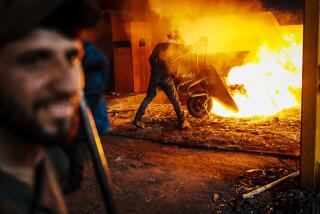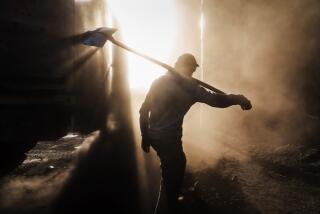Afghan offensive fails to reassure residents
- Share via
Reporting from Kandahar, Afghanistan — On a recent bell-clear autumn afternoon a few miles outside Afghanistan’s second-largest city, villagers listened courteously as a U.S. military officer, speaking through an interpreter whose grasp of the local language seemed shaky, exhorted them to let Afghan police or American soldiers know if the Taliban came to town.
Nodding in agreement amid the group were three men in beards, turbans and sandals who looked, dressed and talked like the other villagers. They were Taliban.
“They were standing right there with us, and everyone was too scared to say anything,” a farmer named Farid, who grows pomegranates in the Arghandab district, northwest of Kandahar, said as he described the encounter last month. Soon afterward, fearing both insurgents and the presence of foreign troops, he and his family fled.
Together with its outlying districts, Kandahar — a cacophonous, chaotic metropolis of more than 1 million people — is the focal point of NATO’s most ambitious military offensive of the 9-year-old war. Long delayed but now gathering in intensity, the campaign’s outcome is described as pivotal to the Western war effort.
North Atlantic Treaty Organization officials characterize the ongoing confrontation as the inexorable tightening of a noose around the Taliban, an enemy depicted as increasingly beleaguered and on the run. In interviews and daily news releases, the coalition tells of firefights in which insurgents are wiped out by airstrikes, carefully plotted night raids by elite Afghan and U.S. troops that pick off Taliban ringleaders one by one, and enhanced security for villagers and townspeople.
But for Kandaharis, both urban dwellers and villagers from the surrounding farmlands, the narrative is somewhat different. They speak of lingering fear and deep skepticism about the NATO operation, despite what they acknowledge to be a decline in overt violence such as suicide bombings and assassinations in the city itself.
Taliban militants, they say, retain near-total freedom of movement inside and outside Kandahar, as long as they stash weapons in a widely scattered network of caches rather than carrying them around. “Night letters,” the insurgents’ dreaded warning missives often aimed at civil servants and prominent tribal elders, still arrive with clocklike regularity. Most disappointingly, local people say, the improved government services touted as equal in importance to the military drive have largely failed to materialize.
“Security is better, but it’s still a wartime situation,” said Kandahar’s mayor, Ghulam Hamidi, interviewed in the governor’s compound, a sprawling fortress in the city center where many senior officials live and work because it is too dangerous for them outside the barricaded walls. “We can’t fill government positions because people are afraid to come and accept these jobs. Everyone is a target.”
The insurgency alone is not the issue, say local observers such as a high school principal who chatted quietly with visitors in one of his classrooms. There, schoolgirls were working at computer terminals; their burkas, which local tradition dictates they must wear when outside their homes, lay in crumpled heaps beside them.
“The conservatism here is so deep,” said the principal, who asked that he not be named for fear of drawing attacks on his school. “We get night letters all the time saying, ‘Stop what you are doing.’ But the bigger problems, the underlying ones, are the tribal rivalries, warlordism and corruption.”
In conversations with Kandaharis, the perceived impermanence of the Western presence is a constant theme — coupled with the Taliban’s ability to fade away and then reappear. Even in areas declared secured by the foreign forces, the insurgents simply bide their time, and then filter back — much as they did in Marja in neighboring Helmand province, which remains a dangerous place more than seven months after a U.S. Marine-led offensive.
One much-touted recent military operation took place in Mahlajat, a farming district on Kandahar’s southwestern fringes. Afghan forces, heavily supported by Western troops, staged a five-day operation in late August that they said largely cleared the district of Taliban fighters.
“In Mahlajat, where you used to see white Taliban flags, and where the Afghan security forces did not go [previously], you now see the Afghan national flag flying,” said U.S. Army Lt. Col. John Voorhees, commander of the 504th Military Police battalion, which has been mentoring Afghan police in the city. “It gives them confidence.”
Residents, however, say they still feel intimidated.
“It’s not safer,” said Hamidullah Rafiq, a Mahlajat farmer who used to grow opium poppies but switched to wheat after a government seed giveaway. He is thinking of switching back, because the insurgents, he said, become angry when farmers who changed crops could no longer pay as much toward a Taliban-imposed tax.
“The Taliban are still in the district in big numbers,” he said, shaking his head. “They come to the door and take food and shelter and whatever else they want from us. We are poor people. What are we supposed to do?”
Moreover, one Kandahar district’s relative safety sometimes comes at the expense of a neighboring one’s. When military pressure is applied in one place, the insurgents most often decamp to another, or take shelter in the city itself — a growing phenomenon, nervous urbanites say.
The Western military is trying to address that “squirting” effect with what it describes as multipronged offensives, such as one kicked off late last month in Kandahar’s Zhari and Panjwayi districts. Code-named Dragon Strike, it is meant to deprive the insurgents of several sanctuaries simultaneously.
At the onset of that operation, a NATO spokesman, German Brig. Gen. Josef Blotz, said insurgents “will not have anywhere to hide” — an assertion met with incredulity by villagers from the targeted areas.
“Nowhere to hide?” echoed a tribal elder from Panjwayi named Haji Abdullah, whose family has farmed there for five generations. “I am sorry, but in fact there are many, many places to hide. Everywhere in the district, they move as they like.”
Adding to Kandaharis’ sense of pressure piled upon pressure, many people displaced from the outer districts by fighting are crowding into the city, some living in miserable conditions.
Farid, the Arghandab pomegranate farmer, does not know how he will reestablish himself when he returns home, as he intends to do. “It is harvest season, and the crop is rotting in the orchards,” he said.
The Western military says one of its primary success stories in Kandahar has come in the form of near-nightly raids targeting midlevel Taliban commanders. Increasingly, these operations are taking place not only out in the districts, but in the city’s precincts — formerly a rarity.
On Monday, NATO’s International Security Assistance Force said one such strike in the western part of the city had snared two senior Taliban leaders who had organized a string of attacks — the latest of 21 such captures in the last 30 days.
“Taliban leaders operating in Kandahar are feeling the heat,” the statement quoted U.S. Army Col. Rafael Torres as saying. “Our joint security forces are intent on securing the city.”
But in a densely populated urban environment, local people are feeling the heat as well. During the course of one such operation last week, the Western military reported that a man who had menaced coalition forces with an assault rifle had been shot and killed.
He turned out to be an off-duty police officer who lived next door, said Col. Fazal Ahmad Shirzad, the police security chief.
“I would say that in these raids, the intelligence is correct about 60% of the time,” he said. “And wrong about 40% of the time.”
Shirzad said as long as the Kandahar operation continues, NATO forces — and even Afghan police and soldiers — will continue to be bedeviled by the difficulty of distinguishing friend from foe.
“Who is a Talib?” he asked. “A man who takes up a gun and fights us. But we are all Afghans, speaking the same language, in the same turbans and getup. We can’t arrest everybody.”
More to Read
Sign up for Essential California
The most important California stories and recommendations in your inbox every morning.
You may occasionally receive promotional content from the Los Angeles Times.













